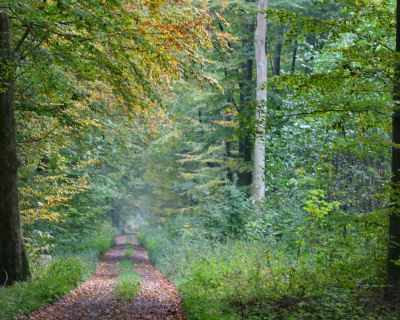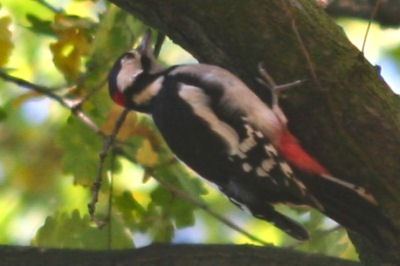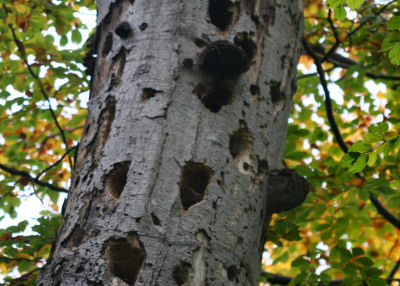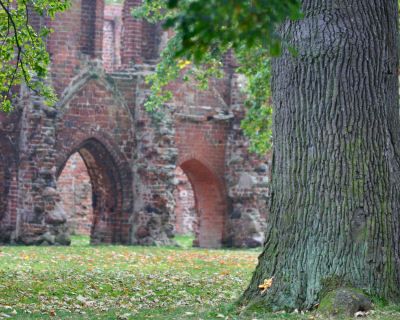Waking up early was easy on my last day in Greifswald as I had slept well after over imbibing a bit the previous night (apparently whenever you order food or drinks or look like you need one proprietors of restaurants in Greifswald give you a free shot). Hendrik and I met up at a more civilized hour than the day before anyway, and enjoyed a brief breakfast before cruising over to the Naturschutzgebiet (Nature Preserve) Elisenhain in Eldena. Our goal was simple: to see woodpeckers that I had not yet seen.
The Naturschutzgebiet Elisenhain is a gorgeous and well-managed forest preserve, predominantly beech and oak trees which are what both Middle Spotted Woodpeckers and Black Woodpeckers, our two target species, prefer. The paths through the forest were actually mostly old cobblestone roads that were often layered with leaves, dirt, and other forest detritus. It was a picturesque place that for some reason reminded me of Sherwood Forest (at least the one from the movies as I’ve never been).

The first woodpecker we found was not one of our target species, but a Greater Spotted Woodpecker, the woodpecker that seemed most common everywhere I birded in Germany. Nonetheless, it was nice to see, and it was also nice to see some of the other common forest birds like Eurasian (Winter) Wrens, Eurasian Nuthatches, European Robins, Chaffinches, Eurasian Blackbirds, and Eurasian Treecreepers.

Great Spotted Woodpecker

Eurasian Blackbird
After walking into the forest for about twenty minutes we heard and Hendrik spotted a woodpecker high up in a tree. We got our bins up and he made the call, “Middle Spotted Woodpecker.” Sure enough, the bird’s sides were lightly streaked, the undertail was pink, not red, and it was not as big as a Greater Spotted Woodpecker. One woodpecker down, one to go.
After some more walking into the forest, guided by Hendrik (and it’s a good thing because I had seriously lost track of where we were in relation to the car), a sound like that of the call of a Pileated Woodpecker came faintly through the forest. Hendrik heard it first, and got me to hear it as well. The call of the Black Woodpecker…
Then, we came upon some handiwork of the Black Woodpecker…

Then, we again heard the call of the Black Woodpecker…
We tried following paths that we thought would lead us to the bird but we failed. The Black Woodpecker, like some comic-book super-villain, would elude us and return to a shadowy lair to continue its plot to drive the birders of the world crazy. Or maybe just me.
We did get great looks at a pair of Eurasian Jays on the way out of the forest. And we saw Wood Pigeons, Goldcrests, Common Buzzards and Song Thrushes, though the Song Thrushes gave poor looks once again.
Back to the car and we were on our way to an amazing tourist destination, sewage ponds! But first we stopped at a long-abandoned monastery to try and fail to find Long-tailed Tits. It was a cool place though.

On to the sewage ponds!













I never thought of the Black Woodpecker as being such a difficult species to find, probably because I hardly ever went out to specifically look for it. I have to make a plan for Mike’s visit, couldn’t bare the shame of not being able to show a Black Woodpecker to the entire 10,000 birds team…
As I think I remarked at the time “*&!!^&*& Black Woodpeckers”. How can a bird so big be so difficult to see? Pah…
Any big day birder in the Eastern US or Canada will tell you that often the hardest bird to find, is one of the largest, the Pileated.
So I can certainly echo Charlie’s frustration in how can large birds hide so well.
Since I’ve only been to Ireland a couple of times, I have seen no European Woodpeckers and from what I’ve read they are pretty rare in Ireland. Last I knew the most common vagrant woodpecker there was actually the Downy Woodpecker from North America!